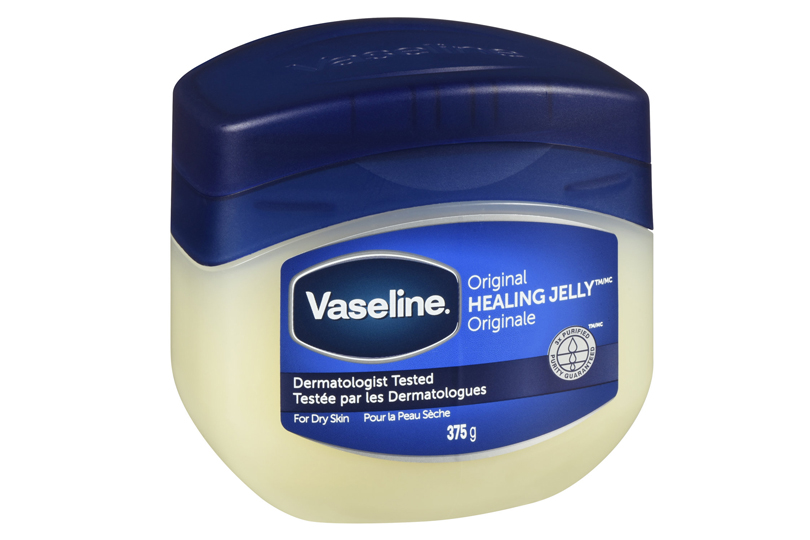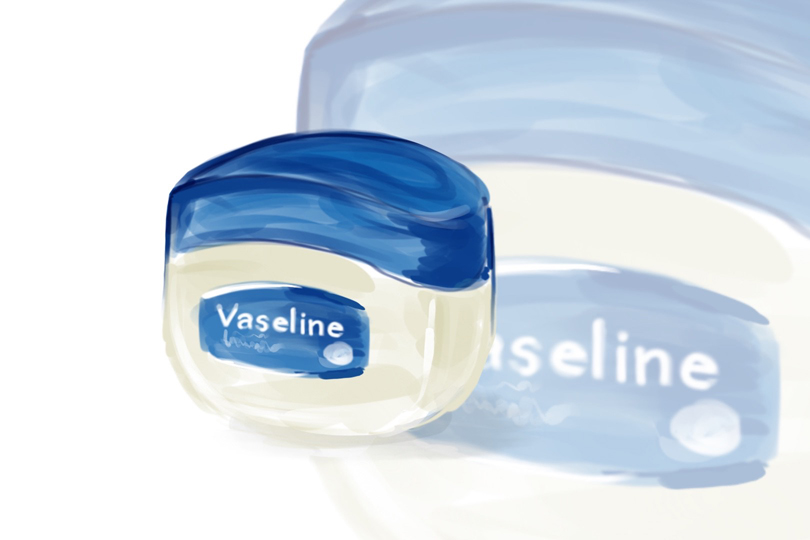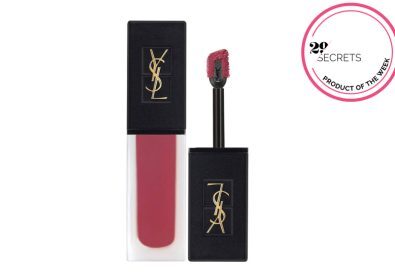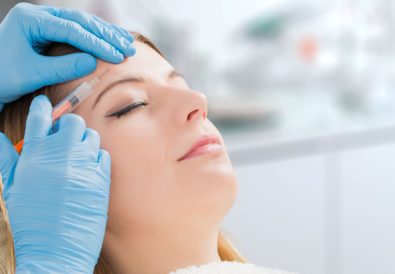Part of an ongoing series of 29Secrets stories, taking a deep dive into the history of legendary beauty products and iconic fashion moments…
By Christopher Turner
Illustration by Michael Hak
Vaseline has been around for more than 150 years – and for good reason. The drugstore staple is one of the most basic, inexpensive and widely available beauty products in history. Long-time beauty lovers swear by it and have coated their faces (and bodies) in Vaseline for decades. It’s also a tried and true cure-all for almost every skin concern imaginable, helping with everything from softening cracked cuticles and smoothing chapped lips to helping heal minor scrapes and burns, to name just a few. Currently Vaseline has a starring role in the popular K-beauty routine known as “slugging” that has been having a viral moment as a catchy TikTok trend (but more on that later).
Certainly, Vaseline is not going to disappear from the shelves or beauty routines any time soon, as a whole new generation of beauty devotees is being introduced to the skin-protecting staple from your grandmother’s medicine cabinet – which means it’s the perfect time to take a look back at its origins. Here’s the history of good old-fashioned Vaseline, or more generally, petroleum jelly, which has been around since the 1870s. Yes, the 1870s…you read that right!
How a gelatinous oil-sludge by-product became a beauty must-have
Vaseline Petroleum Jelly as we know it today was discovered by Robert Augustus Chesebrough, a British chemist who was born in London, England, to American parents on January 9, 1837. Chesebrough was raised in New York City and began his career working in kerosene refining, which was essentially clarifying kerosene from the oil of sperm whales.
Vaseline’s story begins with the discovery of crude oil deposits in Pennsylvania in 1859. After the headline-grabbing discovery, a then-22-year-old Chesebrough spent his life savings to travel from New York to the oil fields in Titusville, Pennsylvania, to meet with oil barons and to research what new materials might be created from the recently discovered fuel. While he was touring the oil fields, he noted men periodically had to halt operations to clean off a thick, dark goo from the oil rig pumps. The gooey substance was accumulating on the sucker rods used to draw the oil to the surface. Interestingly, the oil workers shared that they had been using the gooey substance, which they called “rod wax,” to help heal the cuts and burns they got while working on the rigs. Chesebrough saw the potential in the seemingly worthless substance and took samples of the rod wax away with him.
Back home in Brooklyn, Chesebrough got to work attempting to purify and clarify the rod wax residue into a usable petroleum jelly. He discovered that when he distilled crude oil, he was left with a substance that was effectively identical to the gunk clinging to the drill rods back in Titusville. Eventually, Chesebrough developed sophisticated methods for purifying the goo, screening it through bone black, a kind of charcoal made from the skeletal remains of animals. After spending years perfecting his extracting technique, Chesebrough began using himself as a guinea pig – cutting and burning himself so he could treat his self-inflicted wounds with his newly created colourless, odourless gel.
Chesebrough’s discovery didn’t happen overnight. In fact, it took a decade to successfully convert the rod wax residue from petroleum processing into “a thick, oily, pasty substance” that was “semi-solid in appearance, unobjectionable in odor,” according to the patent for the process of making usable petroleum jelly that was filed in 1872 (U.S. Patent 127,568). “I, Robert Chesebrough, have invented a new and useful product from petroleum which I have named Vaseline…”
Chesebrough came up with the name Vaseline by combining the German word for water (wasser) and the Greek word for oil (έλαιον or oleon), with the addition of –ine for a scientific-sounding ending.
It’s a miracle product…sort of
Chesebrough opened his first Vaseline factory in 1870, two years before the patent was granted, but he couldn’t sell the product because pharmacists simply weren’t interested in buying it. So Chesebrough began to travel around New York and gave away samples at roadside demonstrations of his masochistic experiments. Interestingly, this was one of the first instances in history of the now-common marketing strategy of giving away free samples. The tactic worked, and before long Chesebrough’s roadside customers were heading to their local pharmacies looking for refills of the seemingly miracle product. Of course, the pharmacists had none, having spurned it before, and they began to order it in droves.
It caught on quickly and was found to be suitable for all skin types, as the patented jelly had been purified three times to remove impurities. By 1874, stores were selling over 1,400 jars of Vaseline a day, according to the brand.
So Vaseline’s beginnings and first major success came as medicine, which is ironic because it was later proven that the product had absolutely no curative power whatsoever – the only advantage to its use was that it kept grime and bacteria out of the injuries by forming a protective seal. That’s all.
Of course, Vaseline’s role as a beauty product was just about to begin.
Some seriously life-changing beauty uses
Vaseline could now be found in the medicine cabinet of nearly every household in North America, and it was beginning to catch on around the globe, as people explored the diverse uses for pure Vaseline Jelly. New mothers used it on their babies for diaper rash, and workers exposed to extreme cold weather used it to relieve their dry, chapped skin, but that was just the beginning of its uses. Parents of babies with croup were counselled to warm a half-teaspoon of Vaseline and “let them swallow it.” Not to be outdone, French bakers started using Vaseline in pastries, eager to find a shelf-stable fat that wouldn’t spoil. This particular culinary experiment was fairly short-lived, but many parents around the world continued to feed their children a spoonful of Vaseline well into the 20th century.
But it was women using Vaseline as a beauty aid who ultimately made Chesebrough a millionaire and cemented the product’s legacy in history.

Beginning in the early 1880s, the company began promoting Vaseline as a beauty aid, with one advertisement from 1881 declaring that the product would “keep the skin clearer, softer, and smoother than any cosmetic ever invented, and will preserve the youthful beauty and freshness of the healthy complexion.”
In 1897, the San Francisco Chronicle featured an article sharing the secrets of how “famous women gain and retain good looks.” Their lead case study featured the American socialite Jennie Jerome, better known by this point as Lady Randolph Churchill, the mother of Winston Churchill, one of the most famous politicians of all time. “She is one of those women who are always exquisitely groomed,” the Chronicle noted. “She keeps her youth by means of daily lotions used in the right way.”
And what was the right way? “Every night when she goes to bed she rubs a bit of grease into her face, using sometimes a preparation of tallow and sometimes plain Vaseline. She rubs it into her forehead, for this is where the wrinkles begin to show.” The next morning, the newspaper reported, she washed her face clean. “By this means she keeps her natural beauty always perfect.”
Lady Randolph Churchill wasn’t the product’s only fan, and by the early 1900s Vaseline had become a staple in many women’s daily beauty routines.
To keep up with demand, production of Vaseline was eventually moved to Perth Amboy, New Jersey, and to factories in Canada, Europe and Africa. Chesebrough remained president of the company until 1908, when he retired. In 1955, the Chesebrough Manufacturing Company merged with Pond’s Extract Company to become Chesebrough-Ponds, Inc., and in 1987, that company was purchased by Unilever, the multinational consumer goods company that still owns and produces the Vaseline brand today.
Slugging
Speaking of today…you may have heard the term “slugging” buzzing around the internet in recent years. It refers to the beauty routine of slathering your face in Vaseline to lock in moisture and keep skin hydrated (the term is meant to evoke the thick, slimy mucus trail a slug might leave behind if it crawled across your skin). The skincare practice first went viral on TikTok after Charlotte Palermino, an aesthetician and the co-founder of the skincare company Dieux, mentioned it on social media back in 2020. When the K-beauty skincare trend eventually went viral on TikTok, it was suddenly mainstream, creating a frenzy among beauty advocates and skincare enthusiasts.
Slathering your face with Vaseline is the last step in the popular nighttime slugging routine, and it is meant to help seal in any of the serums or moisturizers that you’ve already applied to your face, helping to retain moisture and ensuring that you wake up with smooth, shiny, soft skin.
It’s a trend that has legs: three years after the initial social media slugging shout-out, the routine is still going strong. Over the past year, there was a 46 per cent increase in the number of views of TikTok videos in which influencers mentioned Vaseline, according to Traackr, which monitors influencer social media data; on Instagram, the number of videos that mentioned Vaseline jumped 93 per cent over the same period. Currently, the “slugging” hashtag has more than 895 million views on TikTok – and that’s just one of the dozens of different hashtags that include slugging.
Dermatologists, long-time beauty experts, moms and nail artists weren’t surprised by the slugging trend, given that Vaseline has been a trusted beauty product for decades. They already knew how Vaseline effectively locks in moisture to keep skin hydrated and plump.
The beauty trend may have introduced Vaseline to a whole new audience, but it is amusing the way some beauty bloggers and TikTok enthusiasts would have you believe the slimy trend is so of the moment. Discovering a new skincare practice can be exciting, especially when the results are positive, but it does pose a challenge when a long-time skincare practice is repackaged as a trend – discounting the generations of women, especially Black women, who partook in it before it even had a name.
“It was recently given a name and made popular by the Korean skincare world; however, growing up with two Black grandmothers, I was ‘slugging’ far before it was popular,” Tiffany L. Clay, a board-certified dermatologist, told Who What Wear. “I remember my grandmother teaching me when I was very young to apply ointment to my body after I bathed to keep me moisturized all day.”
Although “slugging” is often used to refer to skin care for your face, social media users have started introducing “body slugging.” On TikTok, the hashtag counts over 100 million views. (Another practice, “hair slugging,” has over 31 million views on the app.) Again, Black women on social media are questioning the “overnight” trend and pointing out that moisturizing with Vaseline has always been an integral part of their skincare routine.
The takeaway? “Slugging” isn’t a trend, it is common practice.

Everything old is new again
Today Vaseline has become what’s known as a proprietary eponym, like Kleenex or Q-tips. In these cases, a brand can become so famous and so ubiquitous over time that the brand name becomes the face of the entire product category, which is how Vaseline almost always stands in for petroleum jelly.
It’s safe to say that Vaseline’s staying power is thanks in part to Chesebrough’s firm belief in his product. He lived to be 96 years old, and was such a believer in Vaseline that he claimed to have eaten a spoonful of it every day before his death at his house in Spring Lake, New Jersey, on September 8, 1933. He also, reportedly, had his nurse rub him from head to foot with Vaseline when he fell ill during a serious bout of pleurisy in his mid-50s. He credited his eventual recovery, and his life, to Vaseline.
Chesebrough’s unwavering belief in Vaseline set up the product for success and a place in beauty and pop culture history. Marilyn Monroe swore by Vaseline in order to keep her skin soft and glowy, and the man behind her famous visage – makeup artist Allan “Whitey” Snyder – gave countless interviews over the years detailing how he used Vaseline as a primer and highlighter on Monroe and on the faces of his other famous clients (including Katharine Hepburn, Doris Day and Raquel Welch).
More recently? Actress Jennifer Aniston shared that she puts Vaseline all over her eyelids for better lashes. Actress Freida Pinto does the same, for a dewy look. Supermodel Tyra Banks proclaimed it her “biggest beauty secret ever!” American rock band The Flaming Lips even claimed it could be used as a spread on toast in their 1993 hit song “She Don’t Use Jelly.”
Of course, celebrities aren’t the only ones who have been endorsing Vaseline for decades. The general admiration for the product comes down to its effectiveness, which is why it’s been a staple since 1870, preventing chapped lips, cracked heels and blisters, relieving skin sores and cracks, and, yes, helping to deliver glowing, soft skin.
The gelatinous oil-sludge by-product has never gone away, and it probably never will. It will just be repackaged again and again for younger generations to discover it.
![]()
Want more? You can read other stories from our The Story Of series right here.











